PAPERS by Ariadna Sitjà-bobadilla
Jornada de Divulgacion Proyecto Europeo AQUAMAX celebrada en el Instituto de Acuicultura de Torre... more Jornada de Divulgacion Proyecto Europeo AQUAMAX celebrada en el Instituto de Acuicultura de Torre de la Sal (Castellon) el 24 de noviembre de 2010.
Comunicacion presentada en el 9th International Symposium on Fish Parasites, celebrado en Valenci... more Comunicacion presentada en el 9th International Symposium on Fish Parasites, celebrado en Valencia, Espana, del 31 de agosto al 4 de septiembre de 2015
Fish & Shellfish Immunology, Oct 1, 2012
Erratum to "Modulation of the IgM gene expression and IgM immunoreactive cell distribution by the... more Erratum to "Modulation of the IgM gene expression and IgM immunoreactive cell distribution by the nutritional background in gilthead sea bream (Sparus aurata) challenged with Enteromyxum leei (Myxozoa)" [33 (2) (2012) 401e410]
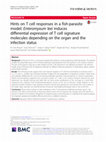
Parasites & Vectors, Jul 31, 2018
Backgroud: Enteromyxum leei is a myxozoan parasite that produces a slow-progressing intestinal di... more Backgroud: Enteromyxum leei is a myxozoan parasite that produces a slow-progressing intestinal disease. This parasite invades the paracellular space of the intestinal epithelium and progresses from the posterior to the anterior intestine. The aim of the present study was to gain insights into fish T cell responses in the gilthead sea bream-E. leei infection model using a PCR-array with 30 signature molecules for different leukocyte responses in head kidney, spleen, anterior and posterior intestine. Results: The PCR-array results suggest that E. leei induced migration of T cells from head kidney to intestines where T H1 , CTL and T H17 profiles were activated and kept in balance by the upregulation of regulatory cytokines. These results were partially validated by the use of cross-reacting antibodies and BrdU immunostaining to monitor proliferation. Zap70 immunostaining supported the increased number of T cells in the anterior intestine detected by gene expression, but double staining with BrdU did not show active proliferation of this cell type at a local level, supporting the migration from lymphohaematopoietic tissues to the site of infection. Global analyses of the expression profiles revealed a clear separation between infected and exposed, but non-infected fish, more evident in the target organ. Exposed, non-infected animals showed an intermediate phenotype closer to the control fish. Conclusions: These results evidence a clear modulation of the T cell response of gilthead sea bream upon E. leei infection. The effects occurred both at local and systemic levels, but the response was stronger and more specific at the site of infection, the intestine. Altogether, this research poses a promising basis to understand the response against this important parasite and establish effective preventive or palliative measures.
Trabajo presentado en la 18th International Conference on Diseases of Fish and Shellfish, celebra... more Trabajo presentado en la 18th International Conference on Diseases of Fish and Shellfish, celebrada en Belfast, del 4 al 8 de septiembre de 2017
Trabajo presentado en el 19th Fish Immunology Workshop, celebrado en Wageningen (Holanda), del 29... more Trabajo presentado en el 19th Fish Immunology Workshop, celebrado en Wageningen (Holanda), del 29 de abril al 3 de mayo de 2018
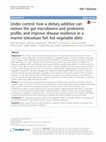
Microbiome, Dec 1, 2017
Background: The constant increase of aquaculture production and wealthy seafood consumption has f... more Background: The constant increase of aquaculture production and wealthy seafood consumption has forced the industry to explore alternative and more sustainable raw aquafeed materials, and plant ingredients have been used to replace marine feedstuffs in many farmed fish. The objective of the present study was to assess whether plant-based diets can induce changes in the intestinal mucus proteome, gut autochthonous microbiota and disease susceptibility of fish, and whether these changes could be reversed by the addition of sodium butyrate to the diets. Three different trials were performed using the teleostean gilthead sea bream (Sparus aurata) as model. In a first preliminary short-term trial, fish were fed with the additive (0.8%) supplementing a basal diet with low vegetable inclusion (D1) and then challenged with a bacteria to detect possible effects on survival. In a second trial, fish were fed with diets with greater vegetable inclusion levels (D2, D3) and the long-term effect of sodium butyrate at a lower dose (0.4%) added to D3 (D4 diet) was tested on the intestinal proteome and microbiome. In a third trial, the long-term effectiveness of sodium butyrate (D4) to prevent disease outcome after an intestinal parasite (Enteromyxum leei) challenge was tested. Results: The results showed that opposed forces were driven by dietary plant ingredients and sodium butyrate supplementation in fish diet. On the one hand, vegetable diets induced high parasite infection levels that provoked drops in growth performance, decreased intestinal microbiota diversity, induced the dominance of the Photobacterium genus, as well as altered the gut mucosal proteome suggesting detrimental effects on intestinal function. On the other hand, butyrate addition slightly decreased cumulative mortality after bacterial challenge, avoided growth retardation in parasitized fish, increased intestinal microbiota diversity with a higher representation of butyrate-producing bacteria and reversed most vegetable diet-induced changes in the gut proteome. Conclusions: This integrative work gives insights on the pleiotropic effects of a dietary additive on the restoration of intestinal homeostasis and disease resilience, using a multifaceted approach.
Frontiers in Marine Science, Nov 26, 2021
Anti-obesogenic Egg Hydrolysate in Sea Bream fish fed the plant-based diet without EWH. In additi... more Anti-obesogenic Egg Hydrolysate in Sea Bream fish fed the plant-based diet without EWH. In addition, in EWH fish, a higher abundance of Propionibacterium was related to an increased concentration of intestinal propionate. The antagonism of gut health-promoting propionate with cholesterol could explain the inferred underrepresentation of primary bile acid biosynthesis and steroid degradation pathways in the EWH fish microbiota. Altogether, these results reinforce the central role of gut microbiota in the regulation of host metabolism and lipid metabolism in particular, suggesting a role of the bioactive EWH peptides as an anti-obesity and/or satiety factor in fish.
HAL (Le Centre pour la Communication Scientifique Directe), Jun 4, 2012
Comunicacion presentada en el XV International Symposium on Fish Nutrition and Feeding celebrado ... more Comunicacion presentada en el XV International Symposium on Fish Nutrition and Feeding celebrado en Molde (Noruega) del 4 al 7 de junio de 2012.

Comunicación presentada en la 19th International Conference on Diseases of Fish and Shellfish, ce... more Comunicación presentada en la 19th International Conference on Diseases of Fish and Shellfish, celebrada en Oporto (Portugal) del 9 al 12 de septiembre de 2019.[Introduction]: In animal production, enteritis is responsible for serious economic losses, being intestinal parasitism a major stress factor leading to malnutrition and lowered performance and production efficiency. The intestinal myxozoan parasite Enteromyxum leei dwells between gut epithelial cells and causes severe desquamative enteritis in gilthead sea bream (Sparus aurata) that impairs nutrient absorption causing anorexia, cachexia, growth impairment, reduced marketability and increased mortality. This study aimed to outline the gut failure produced in this fish-parasite model using a multifaceted approach and to find and validate serum non-lethal markers of gut barrier dysfunction.[Methodology]: Intestinal integrity was studied in parasitized and non-parasitized fish by immunohistochemistry with specific markers for cellular adhesion (E-cadherin) and tight junctions (Tjp-1 and Cldn3) and by functional studies of permeability (oral administration of FITC-dextran) and electrophysiology (Ussing chambers). Serum samples from parasitized and non-parasitized fish were analyzed using non-targeted metabolomics and some significantly altered metabolites were selected to be validated using commercial kits.[Results]: The expression of the tight junction proteins Tjp-1 and Cldn3 was significantly lower in parasitized fish along all the intestine, while no differences were found in E-cadherin labeling. Some parasitized fish showed a significant increase in paracellular uptake measured by FITC-dextran detection in serum. Electrophysiology studies showed a decrease in transepithelial resistance in infected animals, which showed a diarrheic profile when compared to the normal absorptive profile of the control animals. Serum metabolomics revealed 3702 ions, from which the differential expression of 20 identified compounds significantly separated control from infected groups in multivariate analyses (PLS-DA), and even separated groups by intensity of infection. Of these compounds, inosine and creatine were identified as relevant and tested with commercial kits in serum samples.[Conclusion]: This study demonstrates the loss of barrier function induced by the enteric parasite E. leei and underlines key markers to differentiate control and infected fish. The untargeted serum metabolomics approach did not reveal specific effects by the parasite, but more a profile typical of absorption dysfunction and anorexia, which are, of course, part of the disease signs.Funding: ParaFishControl H2020 project (634429), Aquaexcel2020 (652831, TNA AE10004-INTEBREAM), AGL2013-48560-R
Trabajo presentado en la 18th International Conference on Diseases of Fish and Shellfish, celebra... more Trabajo presentado en la 18th International Conference on Diseases of Fish and Shellfish, celebrada en Belfast, del 4 al 8 de septiembre de 2017
Trabajo presentado en el XVI Congreso Nacional de Acuicultura, celebrado en Zaragoza (Espana), de... more Trabajo presentado en el XVI Congreso Nacional de Acuicultura, celebrado en Zaragoza (Espana), del 3 al 5 de octubre de 2017
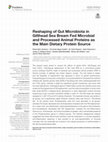
Frontiers in Marine Science, 2021
The present study aimed to unravel the effects of partial (50%; 50LSAqua) and total (100%; 100LSA... more The present study aimed to unravel the effects of partial (50%; 50LSAqua) and total (100%; 100LSAqua) replacement of fish meal (FM) by a commercial protein source (LSAqua SusPro) made of bacterial and processed animal proteins (PAP) in farmed juveniles of gilthead sea bream (Sparus aurata). The trial lasted 8 weeks, and the feasibility of replacement was assessed in terms of growth performance, histopathological scoring and composition of mucosal adherent microbiota from anterior intestine (AI). Specific growth rates (SGR) of 50LSAqua fish were undistinguishable from the CTRL group, whereas a slight but significant growth impairment was found with the total replacement. Histological signs of inflammation across the intestine were more evident at the highest level of FM replacement, and the total concentration of short chain fatty acids (SCFA) in stripped feces decreased in a dose dependent manner. Illumina sequencing of gut mucosal microbiota yielded a mean of 130,439 reads per samp...
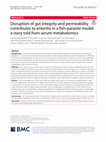
Parasites & Vectors, 2019
Background In the animal production sector, enteritis is responsible for serious economic losses,... more Background In the animal production sector, enteritis is responsible for serious economic losses, and intestinal parasitism is a major stress factor leading to malnutrition and lowered performance and animal production efficiency. The effect of enteric parasites on the gut function of teleost fish, which represent the most ancient bony vertebrates, is far from being understood. The intestinal myxozoan parasite Enteromyxum leei dwells between gut epithelial cells and causes severe enteritis in gilthead sea bream (Sparus aurata), anorexia, cachexia, growth impairment, reduced marketability and increased mortality. Methods This study aimed to outline the gut failure in this fish-parasite model using a multifaceted approach and to find and validate non-lethal serum markers of gut barrier dysfunction. Intestinal integrity was studied in parasitized and non-parasitized fish by immunohistochemistry with specific markers for cellular adhesion (E-cadherin) and tight junctions (Tjp1 and Cldn3...
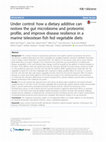
Microbiome, Dec 28, 2017
The constant increase of aquaculture production and wealthy seafood consumption has forced the in... more The constant increase of aquaculture production and wealthy seafood consumption has forced the industry to explore alternative and more sustainable raw aquafeed materials, and plant ingredients have been used to replace marine feedstuffs in many farmed fish. The objective of the present study was to assess whether plant-based diets can induce changes in the intestinal mucus proteome, gut autochthonous microbiota and disease susceptibility of fish, and whether these changes could be reversed by the addition of sodium butyrate to the diets. Three different trials were performed using the teleostean gilthead sea bream (Sparus aurata) as model. In a first preliminary short-term trial, fish were fed with the additive (0.8%) supplementing a basal diet with low vegetable inclusion (D1) and then challenged with a bacteria to detect possible effects on survival. In a second trial, fish were fed with diets with greater vegetable inclusion levels (D2, D3) and the long-term effect of sodium but...
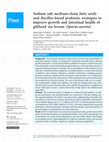
PeerJ, 2017
The increased demand for fish protein has led to the intensification of aquaculture practices whi... more The increased demand for fish protein has led to the intensification of aquaculture practices which are hampered by nutritional and health factors affecting growth performance. To solve these problems, antibiotics have been used for many years in the prevention, control and treatment against disease as well as growth promoters to improve animal performance. Nowadays, the use of antibiotics in the European Union and other countries has been completely or partially banned as a result of the existence of antibiotic cross-resistance. Therefore, a number of alternatives, including enzymes, prebiotics, probiotics, phytonutrients and organic acids used alone or in combination have been proposed for the improvement of immunological state, growth performance and production in livestock animals. The aim of the present study was to evaluate two commercially available feed additives, one based on medium-chain fatty acids (MCFAs) from coconut oil and another with a Bacillus-based probiotic, in g...
Uploads
PAPERS by Ariadna Sitjà-bobadilla